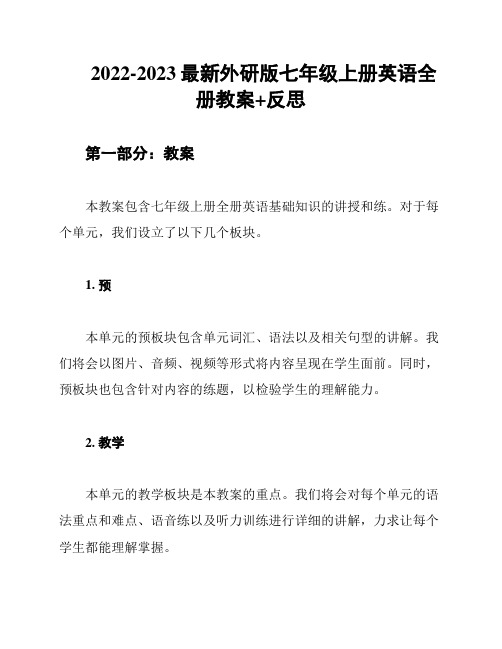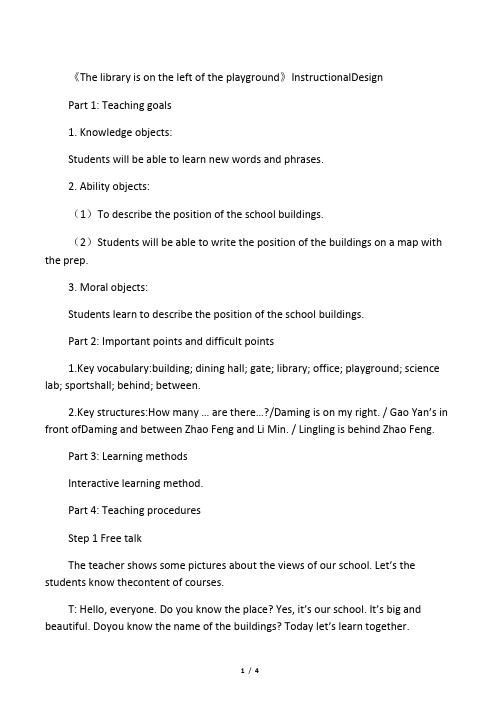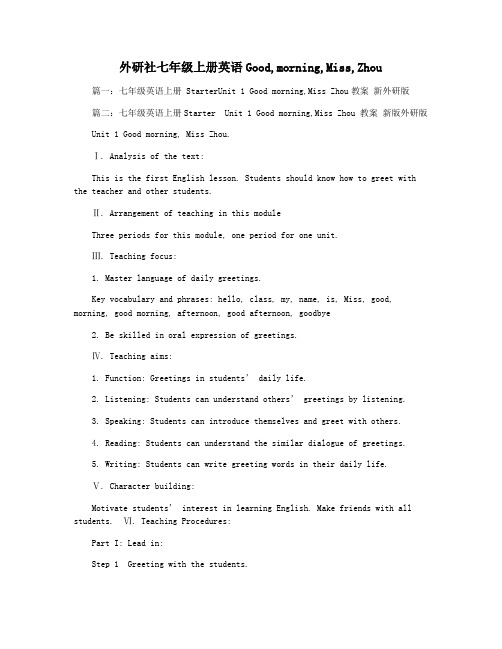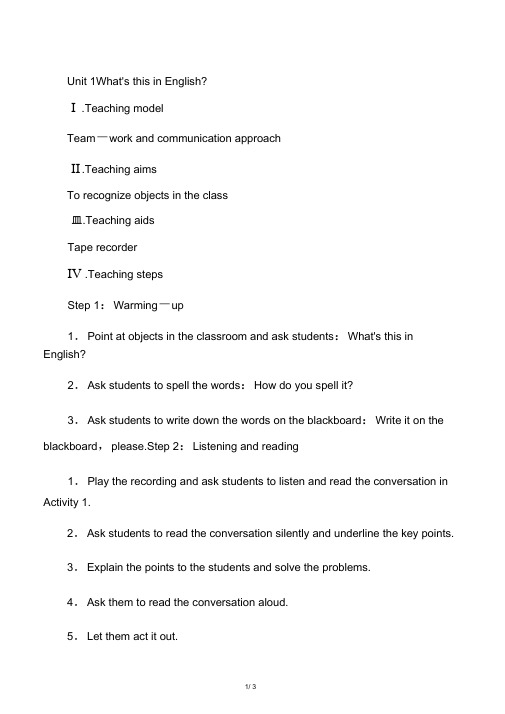外研版七年级英语上册教案
外研版七年级英语上册教案完整版

2)练习询问姓名和相互间的问候。
What’s your name
I’m…
How are you I’m fine, thank you.
3)练习向别人介绍某人This is…
1)Work in pairs part7
教学目标
学习向别人介绍某人的用语
教学重点
This is my…She/He is…
教学难点
Be的变化运用
教具
多媒体、录音机
课时
1
教学课程
.
T: This is my friend…
S: Hello,…This is my father…
T: Nice to meet you.
S: Nice to meet you, too.
S: Hello, Ms…
T: Sit down please.
S: Thank you.
3.Drills
(1)练习打招呼问好。
(2)练习感谢他人。
(3)练习告别语Goodbye。
4.Practise
1)Work in pairs part7 and part8
2) Complete the sentences.
It’s a/an…book,bag,chair,desk…
教学难点
This/that的变化运用;a/an的运用
教具
多媒体、录音机
课时
1
教学课程
.
T: What’s this in English?
S: It’s a book.
T: How do you spell it?
2022-2023最新外研版七年级上册英语全册教案+反思

2022-2023最新外研版七年级上册英语全
册教案+反思
第一部分:教案
本教案包含七年级上册全册英语基础知识的讲授和练。
对于每个单元,我们设立了以下几个板块。
1. 预
本单元的预板块包含单元词汇、语法以及相关句型的讲解。
我们将会以图片、音频、视频等形式将内容呈现在学生面前。
同时,预板块也包含针对内容的练题,以检验学生的理解能力。
2. 教学
本单元的教学板块是本教案的重点。
我们将会对每个单元的语法重点和难点、语音练以及听力训练进行详细的讲解,力求让每个学生都能理解掌握。
3. 课后练
为了帮助学生巩固所学知识,我们将为每个单元提供一系列的
课后练题,希望学生能够认真完成并逐渐提高研究成绩。
4. 复
每个单元的复板块将会提供相关复资料以及复建议,帮助学生
对所学知识进行总结和巩固。
第二部分:反思
我们认为教案不应该只是简单的内容罗列,而是应该引导教师
和学生进行思考和总结。
因此,我们特别设置了反思板块。
1. 教学反思
本板块将会为教师提供一个反思的平台,通过回答一系列问题,帮助教师反思本单元的教学方法、教学效果以及如何更好地提高教
学质量。
2. 研究反思
本板块将会为学生提供一个反思的平台,通过回答一系列问题,帮助学生反思本单元的研究效果、不足以及如何更好地提高研究效果。
我们相信这份教案将会为七年级英语的教学提供帮助,同时也
希望教师和学生认真参考本教案反思自己的教学方法和学习方法,
不断完善和提高自己的能力。
外研版初中英语七年级上册(WY)教案 Module 1 Unit 2

Book1 Module1My classmates一、教学内容:Unit2 I ‘m Wang Lingling and I’m thirteen years old二、课型:Reading and writing三、教学目标:1、能够正确使用下列单词和词组:but, everyone, capital, last name,first name,big,small.2、能够读懂别人的自我介绍的短文。
3、能够对别人进行自我介绍和能介绍别人。
4、在跟不同地区的人交流时,学会尊重不同地域不同的表达习惯,理解他人。
四、教学重难点:1、掌握本课新词和词组2、掌握中外不同的姓名表达习惯:first name, last name3、能够进行简单的自我介绍五、教学准备:课堂整体运用任务型教学模式, 创设真实语境,通过个人呈现,同伴互动,小组活动等师生、生生的交流,充分体现了学生在学习过程中的主体地位,教师只是课堂的引导者,组织者和合作者.本课指导学生通过阅读获取信息,培养学生阅读技能。
在教学过程中,采用多媒体手段辅助教学,利用各种图片和习题任务贯穿整个教学过程。
因此,本节课需准备:PPT课件、课堂练习表格、奖品六、教学过程:words study.1、Lead the students to learn t he new w ords in groups.2、Show the sentences about the new words in this unit and some pictures.3、Choose the little teacher to teach the new words and the teacher correct the mistakes.4、Check the exercise in Activity 1.groups.2、Fill in the blanks.Check the answers with the whole class.3、Little teacher toteach the newwords.The other s toread after the little teacher.4、Competitive in the whole class..estions.②Let the students read Paragraph 1 in groups of six and find out difficulties.③Solve difficulties.T: Let’s continue learning Paragraph 2.(2) Paragraph 2:①Present someread Paragraph 2 and the students listen carefully to point out important Solve lasttalking.knowstudentsblanks③One team studentsread Paragraph 2 and the other students pointout difficultiespoints.④Tosay thedifficulties and solve together.(3)Read the Paragraph3.① Fill in the blanksafter reading paragraph3readingstudents to check the answersfirst andAsk a group of sixread paragraph 3. Let thestudentsandout My name is ______ _______I’mfrom__________.It’s a _____city in England. Tony is my ______name and Smith is my ________name.I’m thirteen______old.It’s nice to_____ you all.②The students check the answers in groups first and then competive.③ A group of six students to read paragraph 3. The other1.Retell.①Let the students fillin the blanks accordingto the pict ure .②Call back the answersfrom two students thenread the short passagein the whole class .2.Speaking①Ask and answer about the people in the pictures.②Ask some students to come to the blackboard and introduce七、板书设计:Module 1 Unit 2 I ‘m Wang Lingling and I’m thirteen yearsoldWhat’s your name? My name is…Where are you from? I’m from…Nice to meet you, … Nice to meet you, too.达标训练题(100分)一、阅读文章,从中找出重要信息填写下面的表格。
2024年外研版七年级英语上册的教学计划(5篇)

外研版七年级英语上册的教学计划一、学生基本情况分析七年级一班共有学生____人,大部分学生的英语基础不是很好,不过这些学生还比较活跃,能够拥有对英语超强的兴趣,作为科任教师,我希望与学生们一起带着希望和梦想,共同学好英语,做一个各方面优秀的人。
新目标(新版)七年级英语(上册)有____个预备篇单元和____个正式篇单元,一共是____个单元。
本次教材是改版后的第____届,现在教材知识体系比较集中,每个单元每节知识点都安排一定的基础练习,这样对巩固学生知识有着很大的帮助。
三、本学期的教学重、难点可以分为两大块来看(一)语法知识点1、一般疑问句及回答;2、指示代词、人称代词、物主代词3、名词复数的变化;4、方位介词;5、特殊疑问句的构成、回答和对划线部分提问6、实义动词的第三人称单数及变化;7、名词所有格;8、一般现在时9、时间表达法。
(二)交际用语(略)英语的教育教学方法很多,各有优、缺点,我们可以针对不同的情况采用不同的教学方法来加以弥补。
针对我教的班级,本学期本人打算用下列方法对他们进行教育教学:1、用英语教英语(TeachEnglishinEnglish);英语毕竟是一门语言,训练的是学生的听、说、读、写、译的综合能力,在教学的过程中需要对学生的听、说、读、写、译的能力进行很多的训练,这就要求我们用英语来教英语,在课堂上对学生进行各种能力的训练。
2、用英语想英语(ThinkEnglishinEnglish);用英语想,也就是用英语思考。
学英语而不用英语思考,一定学不好。
用英语思考就是在用英语进行表达和理解时,没有本族语思考的介入,或者说本族语思考的介入被压缩到了极不明显的程度。
这是真正流利、熟练的境界和标志。
3、背诵和多种练习结合实事求是的说,大量背诵课文与大量多种练习的结合,乃是对于一切各不相同条件下的英语教学的普遍有效的方法。
4、针对不同的教学内容采用不同的教学方法;英语的内容较多,包括语音、词汇、语法、交际等等内容,如果对每一项内容都采用同样的方法来进行教育教学,那么即使是再好的学生也不可能学好,再好的教师也不可能教好。
七年级上册外研版英语教学工作计划

七年级上册外研版英语教学工作计划七年级上册外研版英语教学工作计划(精选7篇)光阴迅速,一眨眼就过去了,我们又将学习新的知识,有新的感受,该写为自己下阶段的教学工作做一个教学计划了,那么如何输出一份打动人心的教学计划呢?以下是店铺精心整理的七年级上册外研版英语教学工作计划(精选7篇),仅供参考,大家一起来看看吧。
七年级上册外研版英语教学工作计划1一、指导思想虽然部分学生在小学已接触过英语,但学生以前不大重视英语,造成英语两极分化严重,且学习积极性低。
所以,现阶段最重要的是激发学生学习英语的兴趣和积极性,帮助他们增强信心,克服困难。
除了从思想上给予引导之外,在教学上,有针对性、目的性、有系统、有计划地上好课。
因此制定教学计划如下。
二、教学措施初一年级是英语学习的基础阶段,也是关键时期。
基础打不好,直接影响学生整个初中阶段,乃至高中、大学的英语学习。
所以做好初一英语的教学工作至关重要。
对此我制定以下措施:(一)注重发音教学,加强语音教学的趣味性语音是语言的基础,学好语音不但有利于正确地以声音的方式表达思想,而且对词汇的学习和记忆力大有帮助。
作为初一的英语教师要特别注重发音的教学,更要重视发音的正确性,克服学生发音不准的缺点。
所以,教师如何讲解4,8个音素的发音要领和发音比较,让学生掌握好发音规律,并且要像小学一样,采用多种的教学方法和充分利用多媒体,让学生感到意兴盎然,增强教学效果,就显得尤其重要。
根据小学对发音教学不够严格的特点,在单词教学中就要注意元音字母组合,元音和辅音字母组合,辅音连缀,以及多音节的划分,句子朗读等方面的准确性和趣味性。
还可以针对初一学生生性活泼好动的特点,选编一些与音素相关的歌谣、歌曲、谜语、绕口令以及小短文等,让学生在有趣的活动中巩固所学音标和读音规则,为掌握好单词打下好基础。
课堂中采取多种多样的教学形式,改变传统的教学模式,提高课堂效率。
多进行一些“英语小竞赛”、“口语交际”、“情景对话”等活动。
外研版七年级英语上册《The library is on the left of the playground》教案3

《The library is on the left of the playground》InstructionalDesignPart 1: Teaching goals1. Knowledge objects:Students will be able to learn new words and phrases.2. Ability objects:(1)To describe the position of the school buildings.(2)Students will be able to write the position of the buildings on a map with the prep.3. Moral objects:Students learn to describe the position of the school buildings.Part 2: Important points and difficult points1.Key vocabulary:building; dining hall; gate; library; office; playground; science lab; sportshall; behind; between.2.Key structures:How many … are there…?/Daming is on my right. / Gao Yan’s in front ofDaming and between Zhao Feng and Li Min. / Lingling is behind Zhao Feng.Part 3: Learning methodsInteractive learning method.Part 4: Teaching proceduresStep 1 Free talkThe teacher shows some pictures about the views of our school. Let’s the students know thecontent of courses.T: Hello, eve ryone. Do you know the place? Yes, it’s our school. It’s big and beautiful. Doyou know the name of the buildings? Today let’s learn together.Step 2 New concepts1. Show some pictures and learn the new words and the new phrases.T: Now look at the pictures and listen to me carefully.What’s the place?We can read books in it.S: Library.T: Yes, it’s a library. Look at this picture. We canwork or study in it.S: Building.T; Yes, they are buildings. Where is the library?It’s on the left of the buildings. Wh ere are the buildings?S: The buildings are on the right of the library.T: We can eat meals in it. It’s...S: It’s a dining hall.The teacher write the phrases on the blackboard and read over and over again.2. Do activity 1Step 3 Games1. Let the students tell us their position .They can use the words on the blackboard. Like this:... is on the left of ......is in front of...... Is between...and...S1: I’m in the middle of the classroom .I’m on the leftof Li Ming.S2: I’m near Lingling. I’m in front of LiMing.2. Guessing Game.Describe one student’s location to the other students and ask them to guess who she / he is.Step 4 Reading1.Read Betty’s words, and write her classmates’ nameson their desk.2. Read activity 3 and label the map of the school and pay attention to the key words.3. Read again and answer the questions in activity4.Give the students several minutes to read again and answer.Then check the answers.1. There are six buildings in the school.2. The playground.3. There are many books, maps and computers.4. There are twenty-four classrooms.5. They are in the science building.Sept 5 DiscussionShow the map of our school to the students and ask them to describe our school. Students arerequired to work in group of four.I’ll give them 4 minutes to prepare. After that, I will invite some students to share theirpassage with the whole class.A: Is there a.... in your school?B: Yes, there is.A: Where’s the…?B:It’s behind/ in front of/ in the middle of…A: Is…behind/ in front of/ in the middle of…?B: Yes, it is. /No, it isn’t.Step 6 WritingDescribe our school according the map. And I will invite some students to share theirpassages with the whole class.For example:This is my school. There are ________. The ______ is behind the _____......Step 7 HomeworkDraw a map of your dream school and introduce the buildings to your classmates.Step 8 Blackboard designdining hallgatebehindlibrarybetween ...andWhere is theoffice?It’sin front ofscience labon the left\rightplaygroundin the middle ofAre there any......?Is there a......?sports hallYes, there are. \ No, there aren’tYes, there is.\No, there isn’t.。
外研社七年级上册英语Good,morning,Miss,Zhou

外研社七年级上册英语Good,morning,Miss,Zhou 篇一:七年级英语上册 StarterUnit 1 Good morning,Miss Zhou教案新外研版篇二:七年级英语上册Starter Unit 1 Good morning,Miss Zhou 教案新版外研版Unit 1 Good morning, Miss Zhou.Ⅰ. Analysis of the text:This is the first English lesson. Students should know how to greet with the teacher and other students.Ⅱ. Arrangement of teaching in this moduleThree periods for this module, one period for one unit.Ⅲ. Teaching focus:1. Master language of daily greetings.Key vocabulary and phrases: hello, class, my, name, is, Miss, good, morning, good morning, afternoon, good afternoon, goodbye2. Be skilled in oral expression of greetings.Ⅳ. Teaching aims:1. Function: Greetings i n students’ daily life.2. Listening: Students can understand others’ greetings by listening.3. Speaking: Students can introduce themselves and greet with others.4. Reading: Students can understand the similar dialogue of greetings.5. Writing: Students can write greeting words in their daily life.Ⅴ. Character building:Motivate students’ interest in learning English. Make friends with all students. Ⅵ. Teaching Procedures:Part I: Lead in:Step 1 Greeting with the students.Step 2 Introduce myself and ask students to introduce themselves to the class. Step 3 Sing a song: Good morning.Part II: Vocabulary study:Step 1 Play the recording and have them point out the words and phrases. Step 2 Play the recording again and have them read after the tape.Step 3 Have the students match the phrases and pictures in PPT.Part Ⅲ: Dialogue study:Step 1 Practise the dialogue with the whole class and have them makecorresponding reacts.Step 2 Have students to practise the previous dialogue with their partner. Step 3 Listen and read.―Hello, class. My name’s Miss Zhou.―Good morning, Miss Zhou―Good afternoon, class.―Good afternoon, Miss Zhou.―Goodbye, class.―Goodbye, Miss Zhou.Listen again and repeat.Step 4 Language points1. Hello, class. My name’s Miss Zhou.Hello! 常用于熟人、朋友和同学之间相互打招呼,表示“你好!”;也可以用在打电话时,意为“喂!”,对方可用Hello!或者Hi!来应答。
七年级英语外研版上册教案:Start

Unit 1What's this in English?I.Teaching modelTeam-work and communication approachII.Teaching aimsTo recognize objects in the class皿.Teaching aidsTape recorderIV .Teaching stepsStep 1:Warming-up1.Point at objects in the classroom and ask students:What's this in English?2.Ask students to spell the words:How do you spell it?3.Ask students to write down the words on the blackboard:Write it on the blackboard,please.Step 2:Listening and reading1.Play the recording and ask students to listen and read the conversation in Activity 1.2.Ask students to read the conversation silently and underline the key points.3.Explain the points to the students and solve the problems.4.Ask them to read the conversation aloud.5.Let them act it out.Step 3:Practice1.Ask the students to look at the pictures in Activity 2.2.Ask and answer like this:—What's this in English?—It's a dog.—What's this in English?—It's a pen.3.Work in pairs.Step 4:Listening practice1.Play the recording of Activity 3,and listen and write.2.Play the recording of Activity 5,and listen and write.A:What's _____________ ?B:_______________ cat.A:How _______________ spell ?“ cat ”B: _______________3.Listen again and check.4.Call back the answers from the whole class and check the answers. Keys:this in English;It's a;do you;C-A-T,catStep 5:Work in pairs1.Ask and answer like this:A:What's this in English?B:A pen?A:No.B:A pencil?A:Yes,a pencil.B:How do you spell “ pen?cil ”A:P-E-N-C-I-L,pencil.2.Work in pairs.3.Finish the workbook.Blackboard DesignUnit 1What's this in English?—What's this in English?—It's a dog.—How do you spell “?dog ” —D-O-G,dog.(1.a bird2.a book3.a cat4.a dog5.a flower6.a pen7.a pencil)。
- 1、下载文档前请自行甄别文档内容的完整性,平台不提供额外的编辑、内容补充、找答案等附加服务。
- 2、"仅部分预览"的文档,不可在线预览部分如存在完整性等问题,可反馈申请退款(可完整预览的文档不适用该条件!)。
- 3、如文档侵犯您的权益,请联系客服反馈,我们会尽快为您处理(人工客服工作时间:9:00-18:30)。
初一英语教案2015 年 4 月1--2 日
教案年 4 月 3 日
教案年 4 月7--8 日
教案年 4 月17--20 日
初一英语教案年4 月21--22 日
初一英语教案年4月23--24 日
初一英语教案年4月27--28 日
初一英语教案年 4 月29--30 日
初一英语教案年5 月4--5 日
初一英语教案年 5 月6--7 日
初一英语教案年 5 月11--12 日
初一英语教案年5 月13--14 日
初一英语教案年 5 月15--18 日
初一英语教案年 5 月19--20 日
初一英语教案年5 月21--22 日
初一英语教案年 5 月25--26 日
初一英语教案年5月27--28 日
初一英语教案年 5 月29 日
初一英语教案年 6 月1--2 日
初一英语教案年6月3--4 日
初一英语教案年 6 月5--8 日
初一英语教案年6月9--10 日
初一英语教案年 6 月11--12 日
初一英语教案年 6 月15--16 日
初一英语教案年6月17--18 日
初一英语教案年6月19--22 日
初一英语教案年 6 月23--24 日
初一英语教案年 6 月25--26 日
初一英语教案年 6 月29--30 日。
